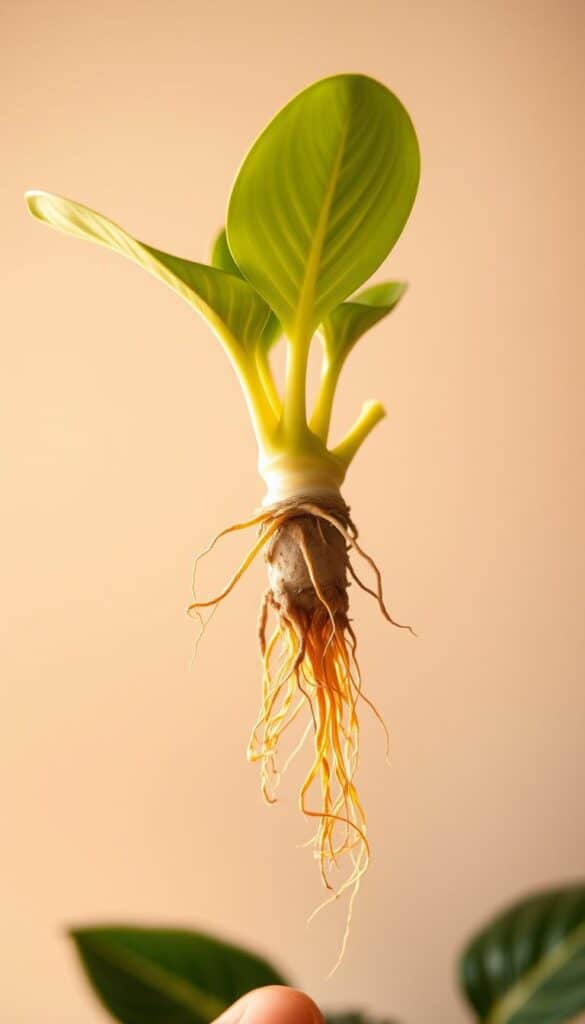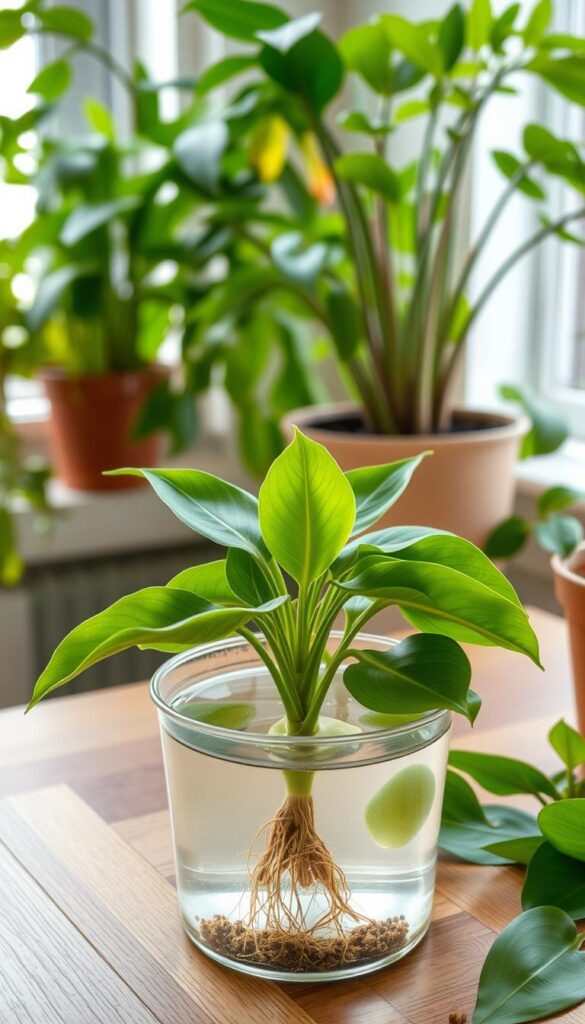Philodendron rooting is both an art and a science. It’s a process that requires attention to detail and a bit of patience. With the right techniques, anyone can successfully propagate these beautiful plants. In this guide, we’ll explore everything you need to know to become a pro at growing philodendrons.
A clean cut is essential for successful propagation. Using sharp, sterilized tools ensures healthy growth and protects your plant from infections. It’s all about creating the perfect conditions for your philodendron to thrive.
I remember my first time propagating a philodendron. It was a mix of excitement and nervousness. But with time, I’ve learned the tricks that make it easy. Whether you’re a seasoned gardener or just starting out, this guide will walk you through both water and soil methods.
Let’s dive into the world of philodendron propagation. With expert tips and real-life examples, you’ll be growing new plants in no time. It’s time to share the joy of nurturing these stunning plants.
Introduction: Discovering the Art of Philodendron Propagation
My journey with philodendrons began when I first laid eyes on their stunning heart-shaped leaves. It wasn’t long before I became fascinated with the idea of propagating these plants. There’s something magical about watching a simple cutting grow into a thriving plant. This curiosity led me to experiment with different methods, and soon I discovered the joy of sharing these beautiful plants with friends and family.
My Journey with Philodendrons
What started as a hobby quickly turned into a passion. I found myself captivated by the simplicity and effectiveness of stem cutting propagation. Experts often recommend using a cup of water and placing the cutting in bright, indirect sunlight. This method allows you to observe the roots forming, which is both educational and rewarding.
Why Propagation Matters for Houseplant Lovers
Sharing a philodendron plant can transform a space and bring life to any room. For those who have struggled with plant care, propagation offers a fresh start. By focusing on healthy nodes and precise cutting techniques, anyone can achieve success. The key is to create the right conditions, whether it’s in water or soil, and to be patient as your cutting grows.
With the right tools and a little care, you can enjoy the benefits of having a thriving philodendron collection. Whether you’re a seasoned gardener or just starting out, propagation is a rewarding experience that connects you with nature and allows you to share your love for plants.
Selecting and Preparing Your Philodendron Cutting
Choosing the right stem cutting is crucial for successful propagation. A healthy cutting sets the stage for a strong, new plant. Here’s what you need to know:
Choosing the Perfect Stem Cutting
A good stem cutting should be 3 to 6 inches long. Look for a section with at least two nodes, the joint-like bumps on the stem. These nodes are where roots will form. Avoid stems with signs of stress or disease, as they won’t propagate well.
Leaves are also important. A healthy cutting should have a few leaves, but remove any lower ones. This helps the plant focus its energy on growing roots instead of supporting too many leaves. The ideal cutting has a visible node and a few top leaves.
Preparing Your Tools and Workspace
Before you start, gather your tools. Sterilized pruning shears or an X-Acto knife are best for making clean cuts. A clean workspace is essential to prevent infections. Wipe down your tools with rubbing alcohol and work on a clean surface.
When cutting, make a 45-degree angle. This increases the surface area for water absorption and root growth. It’s a simple trick that makes a big difference in how well your cutting takes root.
| Method | Advantages | Considerations |
|---|---|---|
| Water | Easy to monitor roots | Requires frequent water changes |
| Soil | Direct planting | Harder to track progress |
For soil propagation, use a mix with peat and perlite. This ensures good drainage and the right balance of moisture. Whether you choose water or soil, proper preparation is key to success.

Step-by-Step Guide: How to Root Philodendron
Rooting philodendron is a straightforward process that can be done in water or soil. Both methods have their advantages, and the choice depends on your preference. Here’s a detailed guide to help you succeed.
Water Propagation Method
This method is ideal for observing root development. Here’s how to do it:
- Place the stem cutting in a glass container filled with fresh water, ensuring the node is submerged.
- Keep the container in bright, indirect sunlight to promote root growth.
- Change the water weekly to prevent bacterial growth.
After 3-4 weeks, you should see roots developing. Once the roots are about an inch long, transfer the plant to a pot with fresh potting soil.
Soil Propagation Method
For those who prefer direct planting, soil propagation is a great option:
- Prepare a pot with a well-draining potting mix containing peat and perlite.
- Plant the stem cutting, ensuring the node is covered with soil.
- Gently firm the soil around the cutting to secure it in place.
Water the soil gently but thoroughly. Keep the soil moist but not soggy to encourage root growth.
Key Practices for Successful Rooting
Regardless of the method, some practices ensure success:
- Maintain a consistent temperature of about 75°F for optimal growth.
- Provide indirect sunlight to avoid overheating the plant.
- Be patient, as rooting can take 1-2 months.
After a few weeks, gently tug on the cutting. If you feel resistance, roots have developed, and your plant is ready to thrive.
Essential Care Tips During Propagation
Proper care during propagation is crucial for your plant’s success. Ensuring the right conditions will help your cutting grow into a strong, healthy plant.
Optimal Light, Temperature, and Humidity
Place your plant in bright, indirect sunlight. Direct sun can overheat the leaves and hinder growth. Maintain a consistent temperature of about 75°F for optimal conditions.
To keep humidity levels around 50-60%, use a pebble tray or humidifier. This creates a nurturing environment for your cutting to thrive.
Maintaining the Right Soil and Water Conditions
Keep potting soil moist but not soggy. Use a mix with peat and perlite for good drainage. For water propagation, change the water weekly to prevent bacteria growth.
Monitor moisture levels carefully. Overwatering can harm the plant, while underwatering may slow root development.

By following these care tips, your plant will have the best chance to develop strong roots and grow into a beautiful houseplant.
Troubleshooting Common Propagation Challenges
When propagating a philodendron, it’s common to encounter a few bumps along the way. Slow root development, overwatering, and poor cutting quality are some of the issues that can arise. By identifying these challenges early, you can take corrective action and help your plant thrive.
Identifying and Addressing Root Health Issues
Root health is crucial for your plant’s success. If you notice the leaves turning yellow or droopy, it might indicate overwatering or root rot. To address this, reduce the frequency of watering and ensure good drainage. For water propagation, change the water weekly to prevent bacterial growth.
Adjusting Techniques to Enhance Growth
Sometimes, small adjustments can make a big difference. If you’re using the water method, try moving the container to a spot with brighter, indirect light. For soil propagation, check that the potting mix is moist but not soggy. Gently tugging on the cutting after a few weeks can help you determine if roots have developed.
| Issue | Symptoms | Solution |
|---|---|---|
| Slow Root Development | Leaves remain small; no visible roots after 4 weeks | Ensure the node is submerged in water or covered in soil; maintain consistent warmth and light |
| Overwatering | Soft, mushy stems; yellowing leaves | Reduce watering frequency; improve drainage; repot with fresh soil if necessary |
| Poor Cutting Quality | Wilting or discolored leaves | Choose a healthy cutting with at least two nodes; remove lower leaves to focus energy on root growth |
Remember, troubleshooting is a natural part of plant propagation. With careful observation and timely adjustments, you can guide your cutting to become a thriving new plant.
Final Steps to a Thriving Philodendron
Once your philodendron cutting has developed strong roots, it’s time for the final steps to ensure it becomes a thriving houseplant. Start by gently removing the plant from its container, taking care not to disturb the roots. Transfer it to a permanent pot with fresh, well-draining soil, making sure all nodes are covered for optimal nutrient uptake.
For plants propagated in water, gradually acclimate them to soil by increasing the soil amount in the container over a few days. This helps prevent shock. Place your new plant in bright, indirect sunlight and maintain consistent watering. As your philodendron grows, adjust its lighting and watering schedule to meet its needs.
By following these final steps, you’ll set your philodendron up for long-term success. With proper care, it will flourish as a beautiful, low-maintenance addition to your indoor garden, bringing joy and freshness to your space for years to come.
